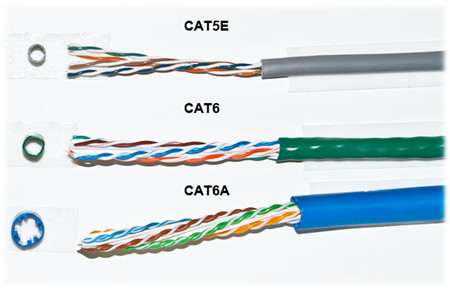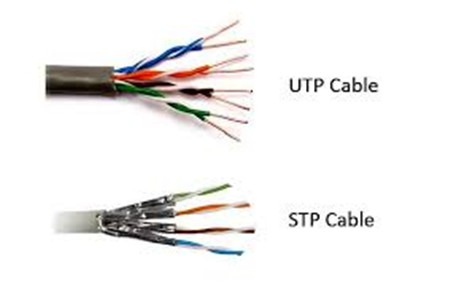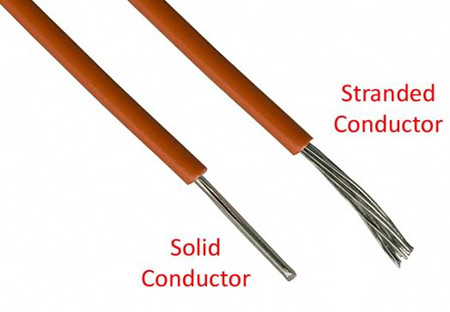Ethernet cable is used to connect devices on local area networks (switch, router or hub), which is one of the most popular forms of fiber jumper cables used on wired networks. Ethernet cables are typically classified into sequentially numbered categories based on different specifications, such as cat5, cat5e, cat6, etc. What are the differences between these category Ethernet cable and how can you know when to use unshielded, shielded, stranded, or solid cable? This article will help you find the suitable one.
Category Ethernet Cable Difference
The Cat3, Cat4, Cat5, Cat5e, Cat6, and Cat7 are the abbreviation for the category number that defines the performance of UTP (Unshielded Twisted Pair) type of cable used for Ethernet wiring outlined by the Electronic Industries Association (EIA) standards. The differences in these cable specifications is not easy to identify. However, as the category number gets higher, so does the speed and Mhz of the wire. The following image shows a comparison between Cat5, Cat6 and Cat6 UTP cables.

Besides the speed and hertz, there are two main physical differences between Cat5 and Cat6 cables, the number of twists per cm in the wire, and sheath thickness. It is known that cable twisting length is not standardized, but typically there are 1.5-2 twists per cm in Cat5e and 2+ twists per cm in Cat6. The amount of twists per pair is usually unique for each cable manufacturer. From the above picture, you can see that no two pairs have the same amount of twists per inch. And Cat5e cable has the thinnest sheath, but it also was the only one with the nylon spline. The nylon spline can help eliminate crosstalk, the thicker sheath protects against near end crosstalk (NEXT) and alien crosstalk (AXT) which both occur more often as the frequency (Mhz) increases.
Nowadays Category 5 cable was mostly replaced with Category 5 Enhanced (Cat5e) cable which did not change anything physically in the cable, but instead applied more stringent testing standards for crosstalk. While Category 6 was revised with Augmented Category 6 (Cat6a) which provided testing for 500 Mhz communication (compared to Cat6’s 250 Mhz). The higher communication frequency eliminated alien crosstalk (AXT) which allows for longer range at 10 Gb/s.
Shielded (STP) vs. Unshielded (UTP)
All Ethernet cables are twisted pair, but they are created equally. Telecom vendors rely on shielding to further protect the Ethernet cable from interference, thus the shielded twisted cable (STP) is more suitable for area with high interference and running cables outdoors or inside walls. Unshielded twisted pair however, can easily be used for cables between your computer and the wall. Technically the picture below shows a UTP and STP cables.

There are different methods to shield an Ethernet cable, but typically it involves putting a shield around each pair of wire in the cable. This protects the pairs from crosstalk internally. Manufactures can further protect cables from alien crosstalk but screening UTP or STP cables.
Solid vs. Stranded
Solid or stranded refer to the actual copper conductor in the pairs. Of an Ethernet cable. Solid conductor uses 1 solid wire per conductor, so in a 4 pair (8 conductor) roll, there would be a total of 8 solid wires. Stranded conductor uses multiple wires wrapped around each other in each conductor, so in a 4 pair (8 conductor) 7 strand roll, there would be a total of 56 wires.

Each type of conductor (see in the above picture) can be utilized in different applications. Stranded cable is more flexible and should be used at your desk or anywhere you may be moving the cable around often. Solid cable is not as flexible as stranded cable, but more durable which makes it ideal for permanent installations as well as outdoor and in walls. Stranded wire are generally made with patch leads with connectors on the either end like LC to SC patch cord.
Conclusion
Due to the electrical transmission characteristics, a single Ethernet cable like an electric power cord, can extend only limited distances. At the end of the article, you may know when to choose STP, UTP, stranded or solid cables. Note that if you're cabling a mission critical system or you want your network to be future proof, go for the CAT6 cables, but for the average home or small office network CAT5 or CAT5e will be just fine.

It was wondering if I could use this write-up on my other website, I will link it back to your website though.Great Thanks.
ReplyDeleteCat6 Cable
Thank you for the information structured cabling service
ReplyDelete